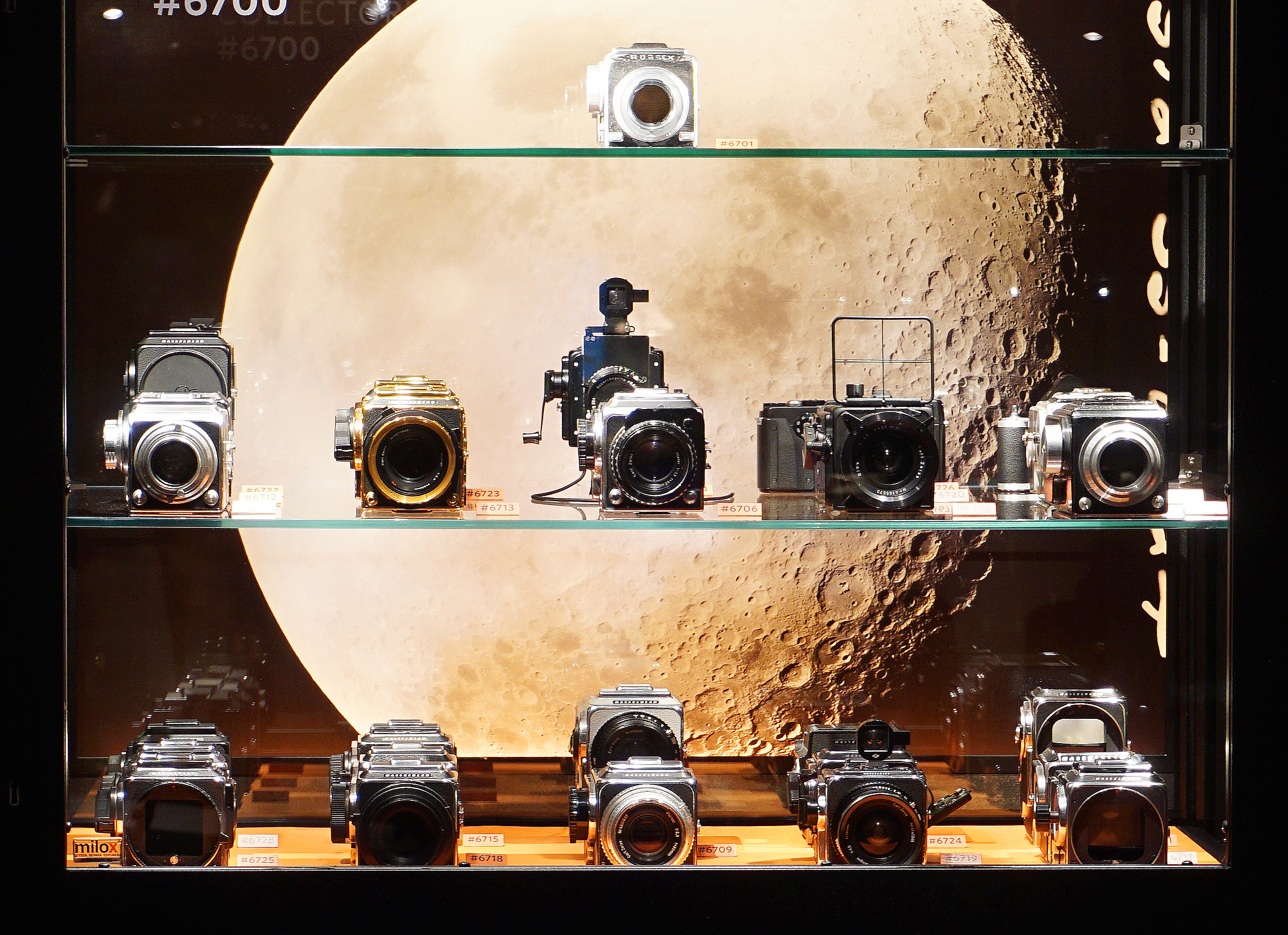
Hasselblad’s first civilian camera, the Hasselblad 1600F, is one of the most innovative and influential cameras in modern times. In 1945 and ’46 the Gothenburg-based company created the first concept drawings and wooden prototypes.
The word Rossex, hand painted on the prototype, was the original proposed name. The camera was launched by Victor Hasselblad himself in New York on 6 October 1948. It was the first medium-format single-lens reflex camera with interchangeable optical components.
Today Hasselblad is still regarded as one of the world’s foremost camera manufacturers. Despite all the various models and technological developments the camera is still recognisable by its distinctive design.Collector’s value involves using persistence and knowledge to acquire all the objects of a certain type or brand.
There are many collectors and even more collections, ranging from children who collect erasers to millionaires who collect sports cars. Hasselblad is interesting to collectors of cameras and technology and also to collectors of items associated with Gothenburg, so called “göteborgiana”.
An object can be valuable because it completes a collection. A bit of wood with no real function or material value can also be precious – in this case how it all began. That is why this prototype stands proudly by itself on the shelf above the large collection of Hasselblad cameras.
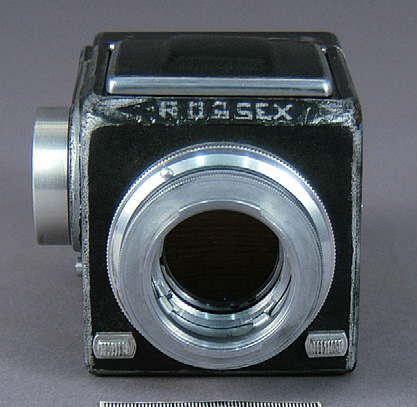
6701
Rossex prototype
A prototype from 1946 of what later became Hasselblad’s first working civilian camera. The prototype is basically a cube made of black-painted wood with metal detailing.
The model name Rossex is hand painted above the lens. The prototypes are often given a name that is later not used for the working cameras. The name Rossex was later changed to Hasselblad. The name of the model was 1600F. The prototype is 14.5 cm deep, 9.5 cm wide and 9 cm high. The weight is 780 grams.
GSM:050020:2
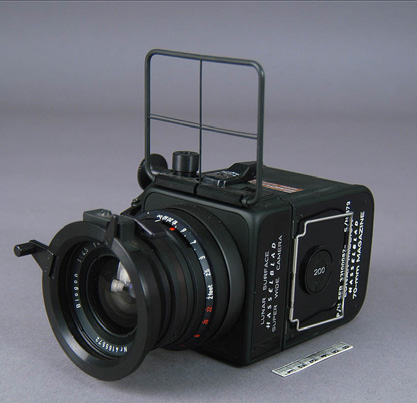
6702
Lunar camera
Hasselblad’s camera designed for use on the Moon. It has the model name of Lunar Surface Super Wide Camera. The camera was made in 1968 for photographing the Moon’s surface. It was intended for use at the 1969 Moon landing but this particular example was never used. The camera is black with white lettering. It is 19.5 cm deep, 13 cm wide and 16 cm high. The weight is 1.45 kg.
The first Hasselblad photographs from space were taken in 1962 by astronaut Walter Schirra. Hasselblad was then given sole right to develop Project Apollo’s cameras, which had to be custom made for the very special conditions on the Moon’s surface. The cameras were left on the Moon. The astronauts wanted to save weight so they would not unnecessarily risk the Lunar Module’s possibilities of returning to the Command/Service Module, which was in orbit around the Moon. Only the film magazines were brought back. Twelve Hasselblad cameras are said to still lie on the Moon’s surface.
GSM:050020:14
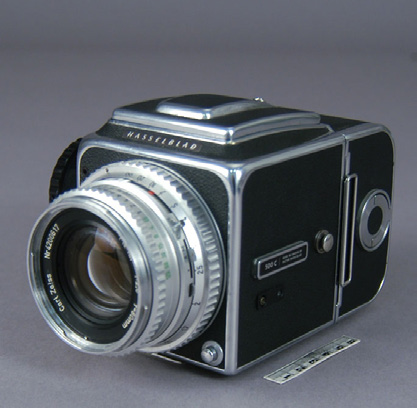
6703
Camera 500C
A camera with the model name 500C. The museum’s example was made in 1963 but the 500C models began being produced in 1957. The camera has a design that many people would call “classic Hasselblad”.
It has a compact rectangular form and is mostly black but has grey elements in the camera’s metal detailing. It is 16 cm deep, 10.5 cm wide and 10,5 cm high. The weight is 1.45 kg.
GSM:050020:6
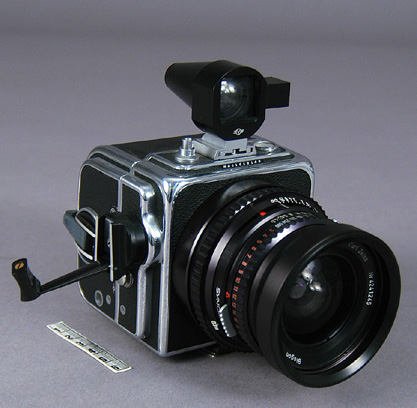
6704
The SWC wide
angle camera
Hasselblad’s Super Wide Camera. The SWC, is, as its name reveals, a camera used for wide angle photography. Production of the models began in 1959 but the museum’s example dates from 1970. The camera is 15 cm deep, 11 cm wide and 13 cm high. The weight is 1.35 kg.
The camera’s construction is based on its lens, which is a true symmetrical wide angle lens. The lens is fixed on a shortened camera body.
GSM:050020:9

6705
Prototype 127
This prototype is named the Hasselblad 127, which refers to 127 film with a 4 x 4 cm image format. 127 film is no longer used much although it can be obtained from some retailers.
The prototype’s appearance is very different from the other Hasselblad cameras in the exhibition. Instead of the rectangular shape, this prototype is 12.5 cm wide but only 7.5 cm deep (including the lens). The height is 10 cm and the weight is 640 grams.
GSM:050020:17

6706
Camera 1600F
A 1600F model camera (the camera for which the Rossex was the prototype). Production of these models began in 1949, with only about 50 units being made in the first year.
This particular example was made in 1950. The camera is black with grey metal detailing. It is 16 cm deep, 10.5 cm wide and 10.5 cm high. The weight is 1.41 kg. The magazine’s appearance first appeared in 1952 and was in use until 1954.
GSM:050020:4
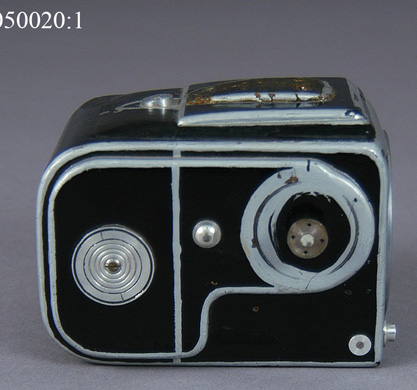
6707
Prototype
We do not know much about this prototype other than what we can see with the naked eye. It is made of wood and was made in the 1940s. On the prototype we can see several places where the black or grey paint has been rubbed off.
Nothing is written on it and nothing has been written about it. Yet it is easy to see that it is indeed supposed to represent a Hasselblad camera. It is 13 cm deep, 10.5 cm wide and 10 cm high. The weight is 760 grams. The prototype does not have a lens.
GSM:050020:1
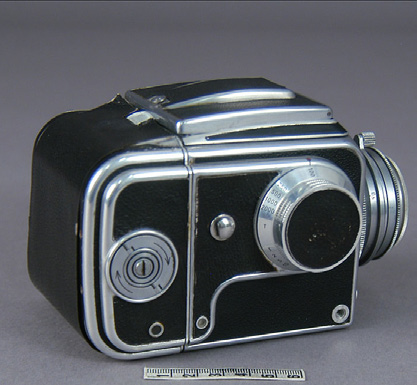
6708
Camera from 1946
A camera made in 1946. The museum does not have much information about this camera other than that it is apparently the first functioning camera model. It is black with metal-coloured detailing. The camera is 15 cm deep, 10 cm wide and 10 cm high. The weight is 1.15 kg.
Do you know anything more?
We’d love to hear!
GSM:050020:3
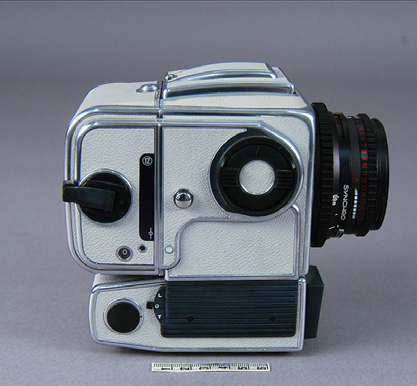
6709
Anniversary camera
An anniversary camera with the designation Gray 500EL/M. The camera was made in 1982 to mark the 20th anniversary of astronaut Walter Schirra’s space voyage during which a Hasselblad was used for the first time in space. Schirra was the third American in space and was not satisfied with the photographs taken on the two previous space voyages.
He took with him a Hasselblad 500C, and that was the beginning of Hasselblad’s involvement in the U.S space programme.
The camera is white with black and metal-coloured detailing. It is 16.5 cm deep, 9.5 cm wide and 14.5 cm high. The weight is 1.87 kg. On the side of the camera body is a plate with the text: “Hasselblad 1962–1982, 20 years in space, No. 0001”.
GSM:050020:24

6710
Prototype 500C
A prototype of the model 500C. It was made in 1974 and is number 1 of a series of 13. The prototype has a lens but no back. The prototype is 12.5 cm deep, 10.5 cm wide and 10.5 cm high. The weight is 960 grams.
GSM:050020:20

6711
Prototype 2000FC
A prototype of the model 2000FC. It was made in 1972 and is 7.5 cm deep, 10.5 cm wide and 9 cm high. The small measurements are due to the fact that the prototype lacks both a lens and a back. Nor is the folding viewfinder that should be on the top in place.
The weight is 600 grams. From the back we can see right into the prototype’s interior.
GSM:050020:22
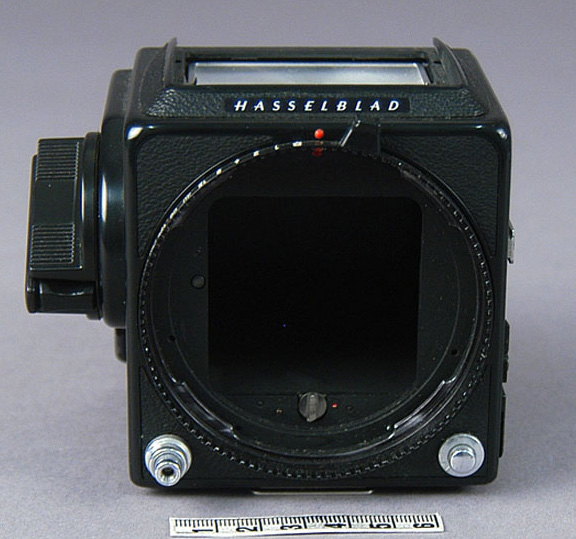
6712
Camera 2000FC
A model 2000FC camera made in 1977. The camera lacks a lens, back and viewfinder. It is 9.5 cm deep, 10.5 cm wide and 9.5 cm high. The weight is 590 grams. The camera is black.
GSM:050020:23
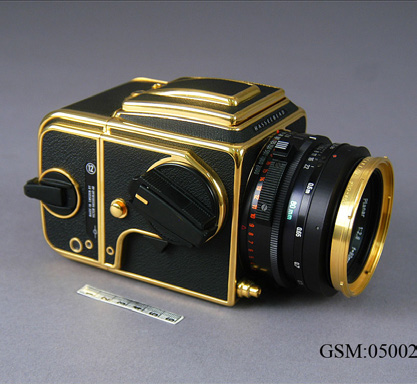
6713
Anniversary
camera
An anniversary camera with the designation Gold 2000FC/M. This anniversary camera was produced in 1985 to mark the founding of the Hasselblad trading company in 1885, but was already assembled in 1984. 1,500 units of the camera were produced and were sold in a specially designed wooden box.
The camera is black with gold-coloured detailing. It is 18 cm deep, 10.5 cm wide and 10.5 cm high. The weight is 1.57 kg.
A gilt silver plate on the side of the camera body states: “Hasselblad 1885–1985, 100 years in photography, Camera No. 001”.
GSM:050020:25
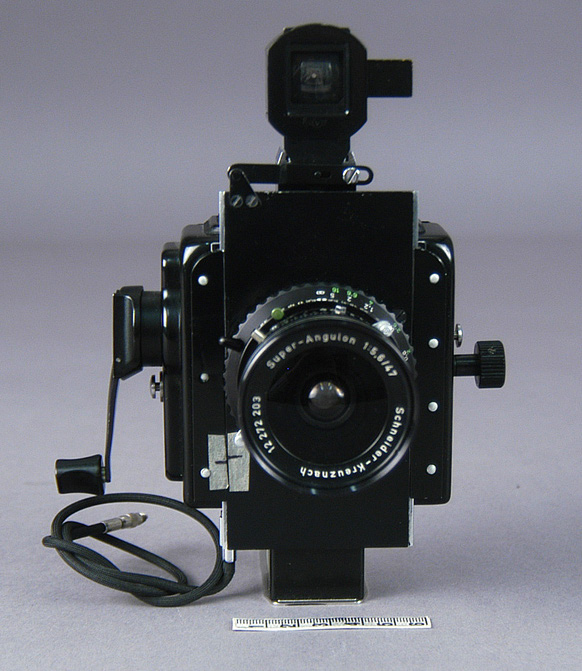
6714
Camera
Super Wide C
A Super Wide C camera made in the 1980s. This camera is described as an experimental camera. It is not very similar to the classic Hasselblad in its appearance but is instead narrow and tall. The depth is 10.5 cm including the lens, the width is 14 cm and the height is 18.5 cm. The weight is 740 grams.
GSM:050020:28
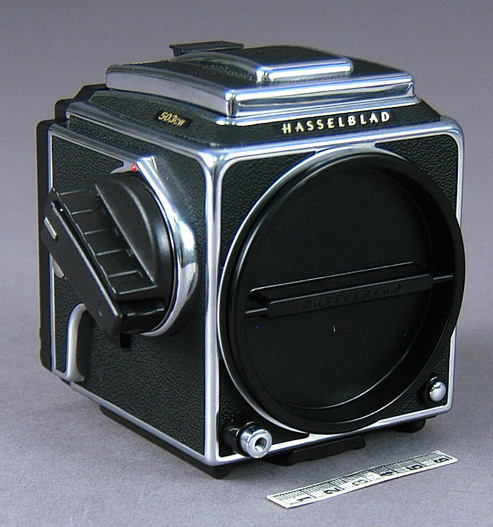
6715
Camera 503CW Millennium
A camera with the designation 503CW Millennium. The camera was made in 2000, which explains its model name, Millennium. The camera lacks a back and lens. It is 9.5 cm deep, 11 cm wide and 10.5 cm high. The weight is 670 grams. The camera is black with metal-coloured detailing.
GSM:050020:34
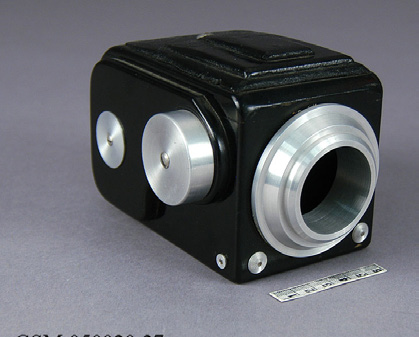
6716
Prototype
This prototype is one of the early ones created in 1945 and 1946. Which model it later became is unclear. The prototype is 14 cm deep, 10 cm wide and 9 cm high. The weight is 630 grams.
The prototype is made of wood and is painted black with metal-coloured detailing.
GSM:050020:37
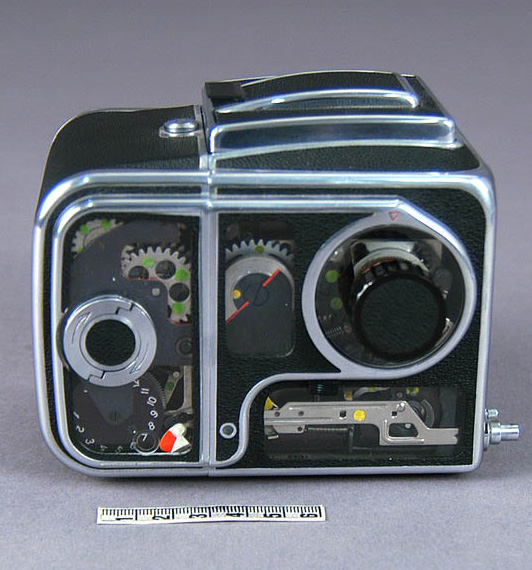
6717
Camera 500C Cutaway
A 500C Cutaway camera made in 1958. The outer shell of the camera body and the magazine has been replaced with Plexiglas windows to reveal the camera mechanism. The parts that are not Plexiglas are black with metal-coloured detailing. The depth is 13 cm, the width is 11 cm and the height is 10 cm. The weight is 900 grams. The camera has a back but no lens.
GSM:050020:10
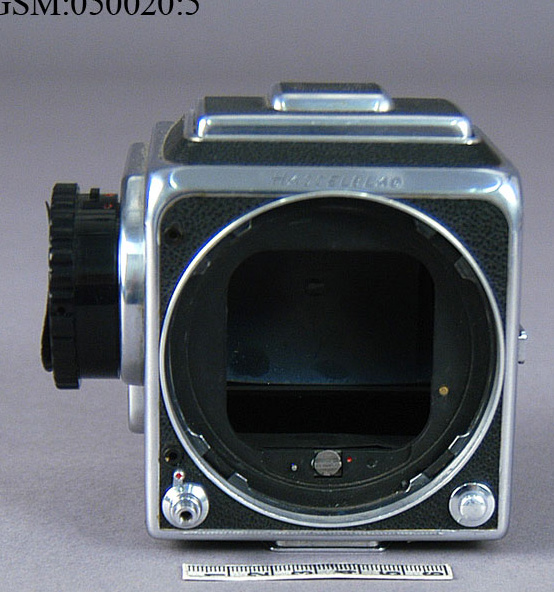
6718
Prototype 500C
A hand-made prototype of the camera body of the model 500C. We know it is hand made because on the back are carved the words in Swedish: “Hand-made prototype 500C”. The 500C was introduced in the autumn of 1957 but the prototype was made in 1954.
At first glance it is hard to see that this is a prototype; it is very much like a working camera in its appearance with its black colour and metal-coloured detailing.
It is 8.5 cm deep, 10.5 cm wide and 10.5 cm high. The weight is 560 grams. It lacks both a back and a lens.
GSM:050020:5
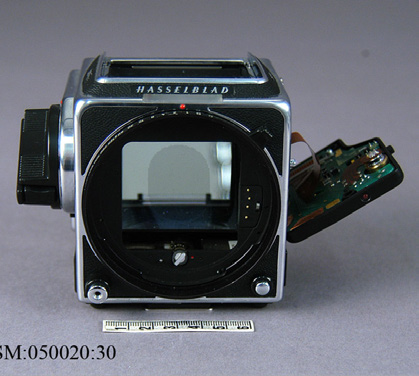
6719
Camera 205TCC
A camera with the designation 205TCC. It was made in 1993 and is Hasselblad’s first electronic camera. Previous cameras had been mechanical ones with electronic aids.
This particular camera is a demonstration unit intended to show the electronics, which explains why it has an open flap on one side of its camera body. It is black with metal-coloured detailing. The folding viewfinder, lens and back are missing. The depth is 9 cm, the width is 15.5 cm with the flap open and the height is 10 cm. The weight is 660 grams.
GSM:050020:30

6720
Prototype with
no body
This prototype shows what a Hasselblad 500C looks like without its outer body. The lack of the body makes it possible to see the camera’s mechanism. The prototype was made in 1960 and is 7.5 cm deep, 10 cm wide and 8.5 cm high. The weight is 370 grams.
The prototype is made of metal and is silver-coloured except for a few green and gold-coloured detailing. The designer was Jan Berglund.
GSM:050020:16
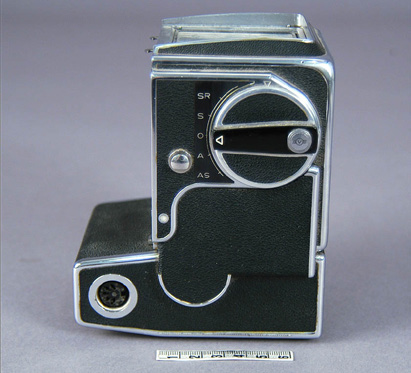
6721
Prototype 500EL
An early prototype of the electrically driven model 500EL. The camera was presented to the market in 1965 but this prototype was made in 1963. The camera lacks the folding viewfinder, lens and back. A motor drive with a battery is attached to the bottom of the camera body. This part is integrated with the camera body, which means that the camera body cannot be used without the motor drive.
The prototype is black with metal-coloured detailing. The designers were Alf Alfredsson and Einar Cronholm. The depth is 11.5 cm, the width is 10 cm and the height is 14 cm. The weight is 1.03 kg.
GSM:050020:11
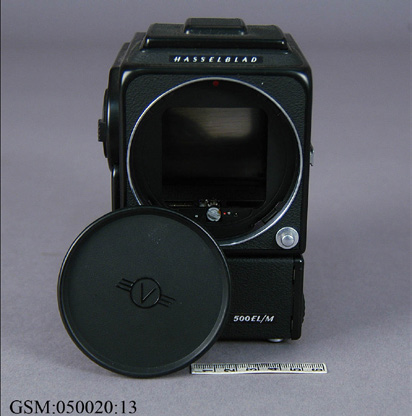
6722
Camera
500EL/M
Cutaway
A camera with the designation 500EL/M Cutaway. This model began being made in 1971 but the museum’s example is from 1975. The sides of the camera body and magazine have been partly replaced with Plexiglas windows to demonstrate the mechanism. Otherwise the camera is all black except for a little metal-coloured detailing.
There is no lens. The camera is 13 cm deep, 9.5 cm wide and 14.5 cm high. The weight is 1.38 kg. A motor drive with a battery is attached to the bottom of the camera body.
GSM:050020:13

6723
Anniversary
camera
An anniversary camera with the designation Gold 500C/M. The camera was made in 1987 to mark the 30th anniversary of the model 500C. The camera is black with gold-coloured detailing.
A silver gilt plate states: “Hasselblad, 500C/M, 1957–1987, Camera No. 0001”. The camera is 18 cm deep, 10.5 cm wide and 10.5 cm high. The weight is 1.53 kg.
GSM:050020:27

6724
Prototype 2000FC
A prototype of the model 2000FC. The prototype has a camera body and a back but no lens. It is all black except for a few metal-coloured detailing. The prototype has the designation HIII and was made in 1970. It is 13 cm deep, 11 cm wide and 10.5 cm high. The weight is 600 grams. The designer was H. Skillius.
GSM:050020:21
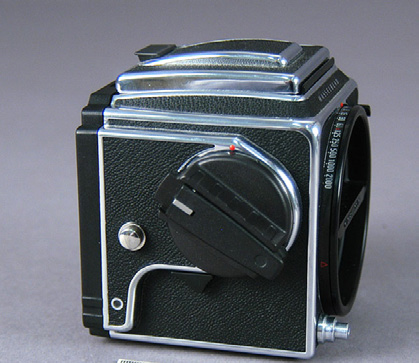
6725
Camera 2000FCW
A camera with the model number 2000FCW. It was made in 1985 and consists of a camera body without a lens or back. The colour is black with metal-coloured detailing. It is 9 cm deep, 10.5 cm wide and 10.5 cm high. The weight is 750 grams.
GSM:050020:29
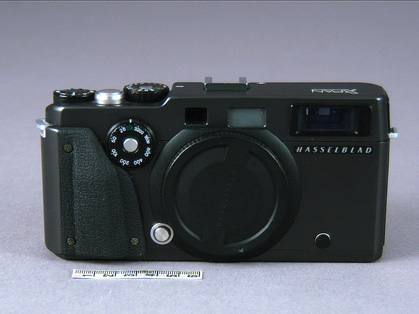
6726
Camera Xpan
This camera named the Xpan makes it possible to take wide-format 24 x 64 mm panorama photographs. The Xpan was introduced in 1998, which was also the year of manufacture of the museum’s example.
Visually it differs much from the form of Hasselblad’s cameras we are used to. Instead of the square camera, this one is shallow and oblong. The widest measurement is 16.5 cm; the camera is 8.5 cm high and 5 cm deep. The weight is 750 grams.
GSM:050020:32
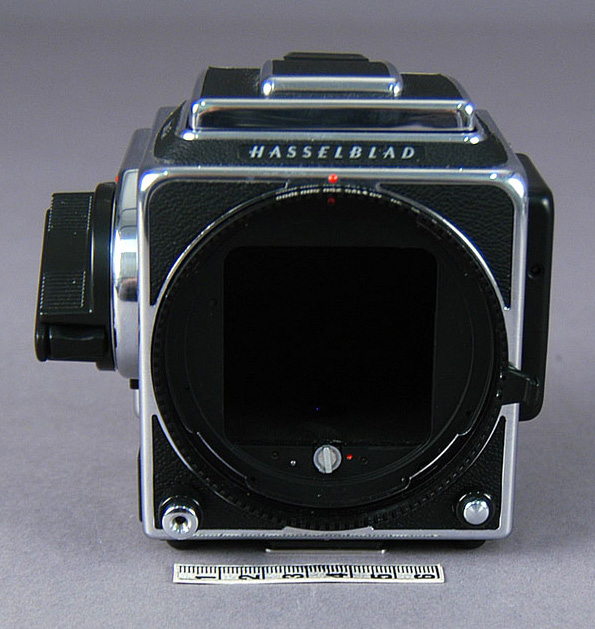
6727
Camera 201F
A camera with the model number 201F. It was made in 1994 and consists of a camera body without a lens or back. The colour is black with metal-coloured detailing. It is 9 cm deep, 11.5 cm wide and 10.5 cm high. The weight is 660 grams.
GSM:050020:31
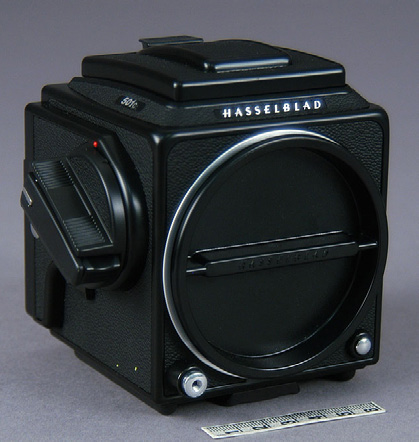
6728
Camera 501C
A camera with the model number 501C. The camera is a further development of the Hasselblad 500C and was introduced in 1994.
The museum’s example was made in 1996. The camera is all black with a few metal-coloured detailing. It is 9.5 cm deep, 10.5 cm wide and 10.5 cm high. The weight is 620 grams.
GSM:050020:33